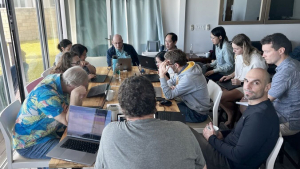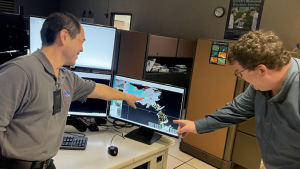
To address pressing water-related issues affecting Hawaiʻi and beyond, the Hydrological Sciences Summit, hosted by the Water Resources Research Center (WRRC), kicked off at the University of Hawaiʻi at Mānoa campus on February 15. The event brought together approximately 30 participants from North America and Hawaiʻi, both in person and via Zoom.
“Hawaiʻi is facing a myriad of water problems from flooding to drought,” said Thomas Giambelluca, director of WRRC. “There are water quality issues, and we have unknown effects of climate change on our water supply. This is an outstanding group of scientists from Alabama and Canada working in areas across North America addressing problems that are similar in some ways and different in some ways to the issues we face in Hawaiʻi. It is a great opportunity, kind of a unique opportunity for us to share knowledge.“

Each presentation provided a platform for participants to delve into critical water-related topics. The subjects included rainfall runoff in Hawaiʻi, estimating rainfall, flooding, coastal flooding, forecasting streamflow and climate adaptation. Following each presentation attendees had the chance to ask questions and engage in discussion.
“We’re coming together with the summit to share what’s going on in each of the institutions and find ways to to have synergy on the ongoing projects, develop ideas for future projects and to better come up with ideas of how to collaborate,” said Steve Burian, professor of hydrology and water resources in the Department of Civil, Construction and Environmental Engineering at the University of Alabama.
In addition to UH Mānoa, the summit included participants from the University of Alabama, University of Calgary and University of Saskatchewan. The diverse representation underscored the global relevance of water-related challenges and the necessity for collaborative efforts to find innovative solutions.

The event resumed on February 16 with a day of discussion and planning held at Giambelluca’s home. A group of the visitors were given tours of field facilities on Maui, Hawaiʻi Island, Kauaʻi, and Oʻahu over the long holiday weekend and on Tuesday.
“It was terrific to connect with Tom Giambelluca and colleagues at the University of Hawaiʻi and see their progress in advancing understanding of the hydroclimate of the Hawaiian Islands,” said Martyn Clark, associate director for the Centre for Hydrology and Coldwater Laboratory at the University of Calgary. “The construction of the Hawaiʻi mesonet program is laying the groundwork to revolutionize our understanding of variability and change across the diverse landscapes in Hawaiʻi. I am looking forward to many fruitful collaborations.”

